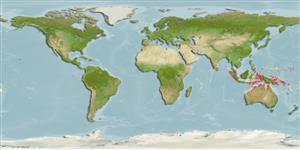Teleostei (teleosts) >
Syngnathiformes (Pipefishes and seahorses) >
Syngnathidae (Pipefishes and seahorses) > Syngnathinae
Etymology: Bulbonaricus: Latin, bulbus, -i = bulb + Latin, naricus = nose.
Environment: milieu / climate zone / depth range / distribution range
Ecology
Marine; reef-associated; depth range 1 - 10 m (Ref. 1602). Tropical; 9°N - 23°S
Eastern Indian Ocean: off Sumatra, Indonesia and from Western Australia. Western Central Pacific: Palau. Japan record needs confirmation (Ref. 43239).
Size / Weight / Age
Maturity: Lm ? range ? - ? cm
Max length : 5.5 cm SL male/unsexed; (Ref. 1602)
Short description
Identification keys | Morphology | Morphometrics
Dorsal fin, pectoral fins, and elongate snout are lost upon metamorphosis to demersal stage. Rings: 17+44-46.
Found on the continental shelf (Ref. 75154). Associated with dendrophyllid corals and the coral Galaxea musicalis (Ref. 1602, 37816). Ovoviviparous (Ref. 205). The male carries the eggs in a brood pouch which is found under the tail (Ref. 205).
Life cycle and mating behavior
Maturities | Reproduction | Spawnings | Egg(s) | Fecundities | Larvae
Male carries the eggs in a brood pouch (Ref. 205).
Dawson, C.E., 1985. Indo-Pacific pipefishes (Red Sea to the Americas). The Gulf Coast Research Laboratory Ocean Springs, Mississippi, USA. (Ref. 5316)
IUCN Red List Status (Ref. 130435)
Threat to humans
Harmless
Human uses
Tools
Special reports
Download XML
Internet sources
Estimates based on models
Preferred temperature (Ref.
123201): 27 - 29.3, mean 28.7 °C (based on 818 cells).
Phylogenetic diversity index (Ref.
82804): PD
50 = 0.6250 [Uniqueness, from 0.5 = low to 2.0 = high].
Bayesian length-weight: a=0.00037 (0.00016 - 0.00085), b=3.18 (2.99 - 3.37), in cm total length, based on LWR estimates for this (Sub)family-body shape (Ref.
93245).
Trophic level (Ref.
69278): 3.2 ±0.5 se; based on size and trophs of closest relatives
Resilience (Ref.
120179): High, minimum population doubling time less than 15 months (Preliminary K or Fecundity.).
Fishing Vulnerability (Ref.
59153): Low vulnerability (10 of 100).
